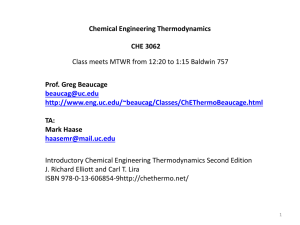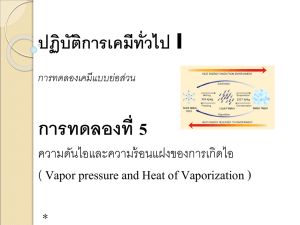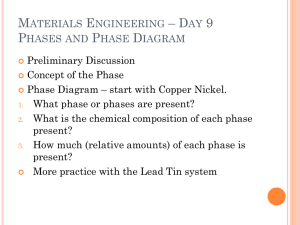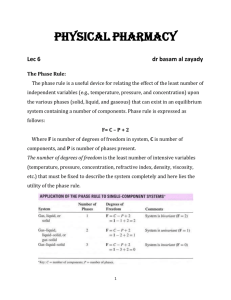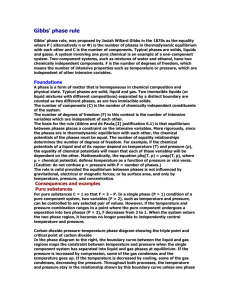Lecture1 - University of Oklahoma
advertisement
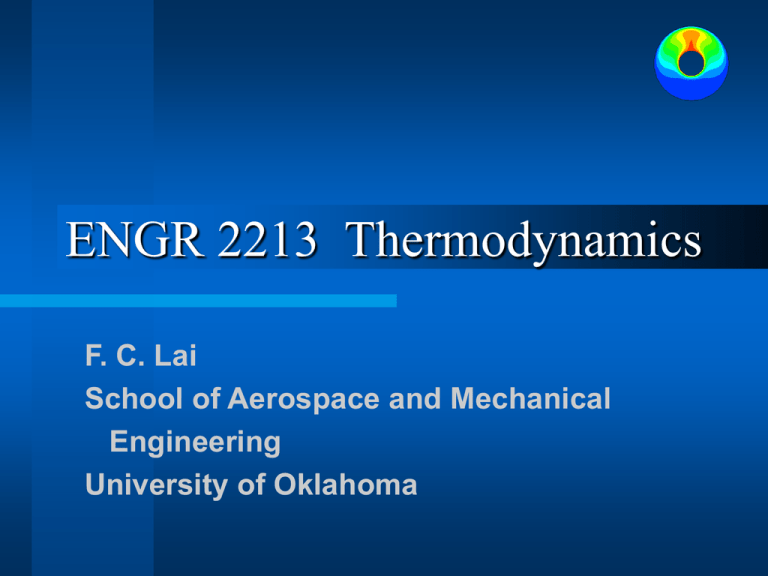
ENGR 2213 Thermodynamics F. C. Lai School of Aerospace and Mechanical Engineering University of Oklahoma Syllabus Instructor Dr. F. C. Lai (FH 218A) Phone: 325-1748, Fax: 325-1088, Email: flai@ou.edu Office Hours: 14:00-15:00 MTWR or by appointment Textbook Thermodynamics – An Engineering Approach by Y. A. Çengel and M. A. Boles, 4th edition, McGraw-Hill, 2002. Course Outline Introduction (1+) ● Basic Concepts ● Properties First Law (2-6) ● Energy Analysis for Closed System ● Energy Analysis for Control Volumes Second Law (7-12) ● Entropy ● Exergy (Availability) Course Outline Power Systems (12-16) ● Vapor Power Systems ● Gas Power Systems Grade ● Homework (8-10) ● Quizzes (3) ● Final Exam 25% 45% 30% Final grade (in absolute scale) 85+ 75-84 65-74 55-64 55- A B C D F Introduction Thermo- dynamics heat force ● Energy → Engineers ● Properties of Matter → Scientists History of Development ~1700 Building a steam engine (T. Savery and T. Newcomen) 1849 First use of the term “Thermodynamics” (Lord Kelvin) 1859 First textbook of “Thermodynamics” (W. Rankine) >1900 Become a mature science Approaches Macroscopic Approach (Classical Thermodynamics) - is concerned with the overall behavior of a system - no model of the structure of matter at the molecular, atomic, and subatomic level is directly use Microscopic Approach (Statistical Thermodynamics) - is concerned directly with the structure of matter - characterize, by statistical means, the average behavior of the particles making up a system of interest and relate this information to the observed macroscopic behavior of the system Definitions • System • Surroundings • Boundary system the subject of the analysis everything external to the system the surface that separates the system from its surroundings surroundings Definitions • System • Surroundings • Boundary the subject of the analysis everything external to the system the surface that separates the system from its surroundings boundary Systems Closed Systems - A fixed quantity of matter There can be no transfer of mass across its boundary Energy, in the form of heat or work, can cross the boundary The volume of a closed system does not have to be fixed Control Volumes - A fixed volume in space through which mass may flow - It usually enclose a device which involves mass flow such as a compressor, turbine, or nozzle Systems Piston and Cylinder Assembly Closed System Water Heater Systems Piston and Cylinder Assembly Closed System Water Heater Control Volume Properties Macroscopic characteristics of a system to which numerical values can be assigned. Extensive Properties Properties that their values depend on the size or extend of a system. Examples: mass, volume Intensive Properties Properties that their values are independent of the size or extend of a system. Examples: temperature, pressure Properties ● Divide and Conquer ● Rule of “Sum” For a quantity, if its value for a system is the sum of its values of each partition, then it is an extensive property. Properties ● Divide and Conquer ● Rule of “Sum” For a quantity, if its value for a system is the sum of its values of each partition, then it is an extensive property. M = M 1 + M2 + M3 + M 4 Mass is an extensive property 1 2 3 4 Properties ● Divide and Conquer ● Rule of “Sum” For a quantity, if its value for a system is the sum of its values of each partition, then it is an extensive property. V = V1 + V2 + V3 + V4 Volume is an extensive property 1 2 3 4 Properties ● Divide and Conquer ● Rule of “Sum” For a quantity, if its value for a system is the sum of its values of each partition, then it is an extensive property. P = P1 = P2 = P3 = P4 1 2 3 4 Pressure is not an extensive property Properties ● Divide and Conquer ● Rule of “Sum” For a quantity, if its value for a system is the sum of its values of each partition, then it is an extensive property. T = T1 = T2 = T3 = T4 1 2 3 4 Temperature is not an extensive property Properties Specific Properties - Extensive properties per unit mass - A specific property is an intensive property Examples: specific volume V v m m V density Basic Concepts State The condition of a system as described by its properties Process A transformation from one state to another At a given state, each property has a definite value that is Independent of how the system arrived at that state. Basic Concepts The change in value of a property as the system is altered from one state to another is determined solely by the two end states and is independent of the particular way the change of state occurred. A quantity is a property if, and only if, its change in value between two states is independent of the process. Basic Concepts Denver OKC Latitude Denver 39º 45’ OKC 35º 24’ Longitude 104º 52’ 97º 36’ Elevation 5280’ 1285’ Basic Concepts Phase A quantity of matter that is homogeneous throughout in both chemical composition and physical structure. Homogeneous in physical structure means that the Matter is all solid, all liquid, or all vapor (gas). A system can contain one or more phases. For example: water and vapor 2 phases Basic Concepts Phase A quantity of matter that is homogeneous throughout in both chemical composition and physical structure. Homogeneous in physical structure means that the Matter is all solid, all liquid, or all vapor (gas). A system can contain one or more phases. For example: water and vapor 2 phases water and oil 2 phases Basic Concepts Phase A quantity of matter that is homogeneous throughout in both chemical composition and physical structure. Homogeneous in physical structure means that the Matter is all solid, all liquid, or all vapor (gas). A system can contain one or more phases. For example: water and vapor 2 phases water and oil 2 phases water and alcohol 1 phase Basic Concepts Phase A quantity of matter that is homogeneous throughout in both chemical composition and physical structure. Homogeneous in physical structure means that the Matter is all solid, all liquid, or all vapor (gas). A system can contain one or more phases. For example: water and vapor 2 phases water and oil 2 phases water and alcohol 1 phase oxygen and nitrogen 1 phase Basic Concepts Pure Substance One that is uniform and invariable in chemical composition A pure substance can exist in more than one phase A uniform mixture of gases can be regarded as a pure substance provided it remains a gas and does not react chemically Equilibrium A state of balance In an equilibrium state, there are no unbalanced potentials (driving forces) within the system. Thermodynamic Equilibrium ● Thermal Equilibrium ● Mechanical Equilibrium ● Phase Equilibrium ● Chemical Equilibrium Thermodynamic Equilibrium Thermal Equilibrium ● ● The system involves no temperature differentials Temperature is uniform in the system Mechanical Equilibrium ● ● No change in pressure at any point in the system The pressure may vary within the system with elevation as a result of gravitational effect Thermodynamic Equilibrium Phase Equilibrium ● The mass of each phase remains the same Chemical Equilibrium ● ● Chemical composition does not change with time No chemical reactions occur Basic Concepts Quasi-Equilibrium Process A process that proceeds in such a manner that the system remains infinitesimally close to an equilibrium state at all times A quasi-equilibrium process is an idealized process to approximate an actual process Basic Concepts Process Path The series of equilibrium states through which a system passes during a process To describe a process completely, one needs to specify the initial and final states of the process, as well as the path it follows Steady State Properties of the system does not change with time Cycle A sequence of processes that begins and ends at the same state



